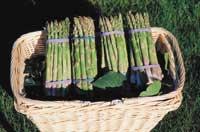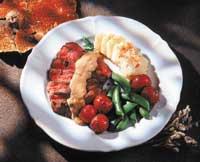Asparagus
Shortly after eating asparagus, anyone can notice that urine acquires a characteristic odor, because the substance called sparragine of this vegetable passes into the urine.
From a nutritional point of view, it is a food with very few calories (10-20 kcal per 100 g): it does not have fats or carbohydrates, although it is one of the richest protein vegetables (2.28%). It contains enough fiber (2.1%), vitamins A, C and E, and in those of group B it is abundant folic acid.
Therefore, it is highly recommended for pregnant women, since in pregnancy the needs of this vitamin are doubled. Potassium, phosphorus, iron and magnesium stand out in mineral salts.

In general, it can be said that, despite its low kcal content, you have a nutrient-rich meal.
All these characteristics make it advisable especially in the following cases:
- Constipation: because it has a lot of fiber.
- Skin eczematan: cleanser and detoxifier.
- Kidney problems and urinary retention: asparagus is very diuretic and produces urine in the kidney. However, those affected by nephritis (inflammation of the kidneys) should take extreme precautions as it greatly affects the kidneys, which can cause damage in cases of nephritis.
- Obesity problem: because of its low kcal content.
Some ways to prepare asparagus
- Asparagus cream: half a kilo of peeled asparagus, cleaned and cut into small pieces. In the pot put a liter of water and salt and cook asparagus. Then pass the blender and the purifier. To this is added half a liter of milk, which is a diuretic and a cream rich in vitamins.
- Asparagus tortilla: the asparagus is cooked and prepared to the tortilla; they can be eaten alone, and with a little fresh garlic and spring onions are very sweet.
- They can also be added to any Russian salad or salad.
- Asparagus with rice: cook the rice and put fried asparagus or bake around.
Asparagus is not recommended for people with a high level of uric acid in blood or gout, since asparagus has a lot of purine, which produces uric acid.
Throughout the year we mainly consume preserved asparagus. They lose vitamins and fiber, although they resist mineral salts and diuretic substances. But since asparagus is from this time, at this time of year we encourage you to consume fresh.
There are two types of fresh asparagus: white and green. The latter are finer and have a sweeter flavor, also have more vitamins A and C. Since asparagus is collected fresh and hardens gradually, it is recommended to buy it and consume it the same day. Otherwise they will be kept wrapped in a paper or fabric in the refrigerator.
If they are very hard, it is advisable to peel and can be prepared in several ways: the most common is to cook (they take 5-10 minutes) and eat in salad or with a little oil. During cooking it is convenient to place the tip on top as it is softer than the rest and requires less cooking time. Fried and roasted in the oven are also very sweet.
We invite you to eat this sweet vegetable during the summer.
EINUT: Nutrition Survey of the Autonomous Community of the Basque Country
Currently, the main causes of mortality in developed countries are closely related to diet, alcohol and tobacco use and sedentary lifestyle. In addition, we must not forget that the genetic basis of each of them and the tendency to suffer certain diseases also influence.

Research on food consumption is also essential when planning food for the inhabitants of a territory and analyzing its impact on health. All this information helps optimize food interventions.
In this sense, the objective of the EINUT-I study was to analyze the consumption of food typical of adults in the Basque Country, in order to identify through biological and hematological values the risk groups from the nutritional point of view.
In the Basque Country, a representative random sample was selected between 25 and 60 years of 2,348 people (1,143 men and 1,205 women). The research was conducted between 1988-1990, during which three interviews were conducted. The first and third were performed in the health centers of Osakidetza and the second in the home of each of them. In addition, along with the third interview blood tests were also performed. The data collected are:
- Personal data, socio-economic level, profession and characteristics of the family and the environment in which they lived.
- Diseases and medications ingested.
- Using the 24-hour method, consume 3 days of food.
- Consumption of alcoholic beverages.
- Anthropometric characteristics: weight, height and skin folds (bicipital, tricipital…).
- Number of physical exercises performed.
- Hematological and biochemical indicators of nutritional status.

On the other hand, the EINUT-I study also measured alcohol consumption: in the case of men 11% of the energy ingested came from alcohol, while in the case of women the amount was 3%.
As a result, experts found that the distribution of energy in the diet was not balanced enough: 16% of energy came from protein (instead of 10-15%), 37% from fat (instead of 25-30%) and 46% from carbohydrates (instead of 55-60%). Therefore, the diet was unbalanced and this was clearly reflected in blood tests, among which 39% of men had cholesterol levels above enough (above 225 mg/dl).

Regarding vitamin A and folic acid, 20% of men and 30% of women did not meet the recommended needs (folic acid is mainly obtained from green leafy vegetables and vitamin A from orange vegetables, among others).
All this shows us the need to incorporate in our daily diet more fiber, green beans, dairy and vegetables and less food of animal origin.





